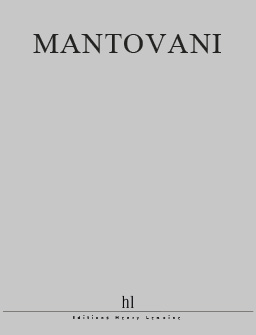Bruno Mantovani
Fiche
- Effectif instrumental
Flûte et piano - Durée
10' - Date de parution
01/01/2001 - Commanditaire
Centre Acanthes et Musique Nouvelle en Liberté - Création
18/11/2001
Paris
Salle Gaveau
Alexis Kossenko (flûte, premier prix du Concours Jean-Pierre Rampal) et Reiko Hozu (piano)
Commander chez l'éditeur
Contacts
Les œuvres de Bruno Mantovani sont éditées aux Editions Henry Lemoine
Editions Henry Lemoine
27, boulevard Beaumarchais
75004 PARIS - France
Musique contemporaine
Tél. : 33 (0)1 56 68 86 74
Service orchestre
Tél. : 33 (0)1 30 90 56 36
Appel d'air

Notice
Writing for an orchestral instrument and piano is one of the most difficult composition exercises I know of. The natural hierarchy that springs up between the single-line "soloist" and the "accompanist" tends to dry up the imagination. In order to escape the sacrosanct mould of the accompanied melody, or a violently virtuoso fantasia in which the piano is reduced to the role of a rhythmic engine, the two instruments have to be considered as a single entity, as a single curtain to be raised on the musical ideas. In the present instance, however, I was unable to put the flute and the piano on an equal footing because the work I had to write, in response to a joint commission from the Acanthes centre and Musique Nouvelle en Liberté was for the sixth international Jean-Pierre Rampal flute competition. The requisites proper to this genre, or rather musical function, are manifold: the piece should display the performer's energy, his or her technical ability and sense of form, among other aspects. I therefore decided to "neutralise" the two instruments in turn, treating the musical matter in the style of "a figure against a background" (to borrow a term from electroacoustic music). The drama of the piece resides in the alternation of soli (obviously more often given to the flute than the piano), during which one instrument occupies the foreground while the other provides a sort of continuo in sound (using trills, resonance, and so on). So whether the flute is to the fore, or whether it is contributing to a general crescendo (during the central piano cadenza), it is almost uninterruptedly present. By this I mean that the performer has to prepare the breathing points with the greatest of care. It is this that constitutes the greatest technical difficulty of the work, hence the title ("Call for air").
Appel d'air is dedicated to Anna Scalfano, and was first performed 18 November 2001 at the Salle Gaveau in Paris by Alexis Kossenko on the flute (prize-winner of the sixth Jean-Pierre Rampal competition) and Reiko Hozu, piano.
Bruno Mantovani
Recording
1 CD aeon,
Jazz Connotation - Les Danses interrompues - D'un rêve parti - Bug - Appel d'air - Früh
Ensemble Alternance, B. Mantovani